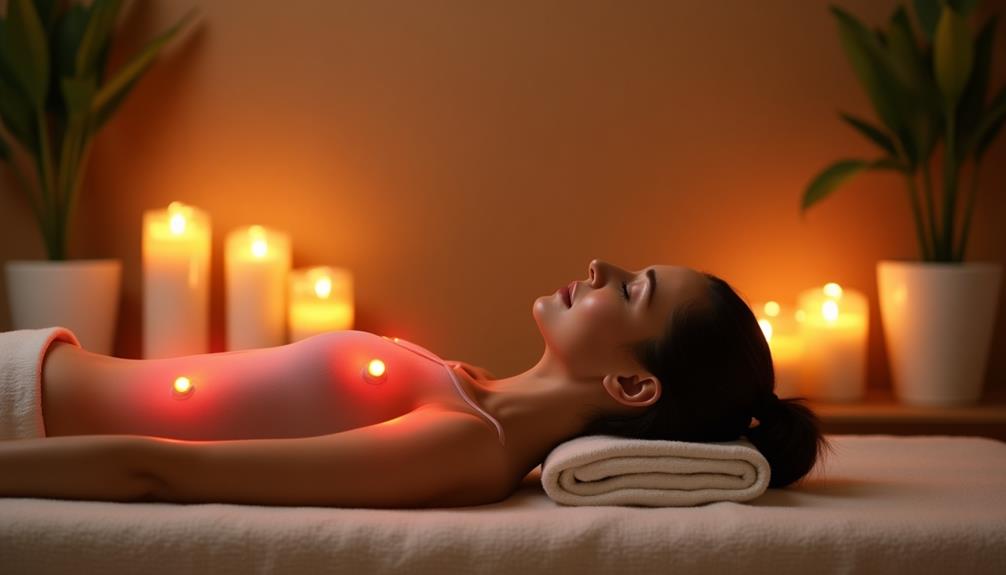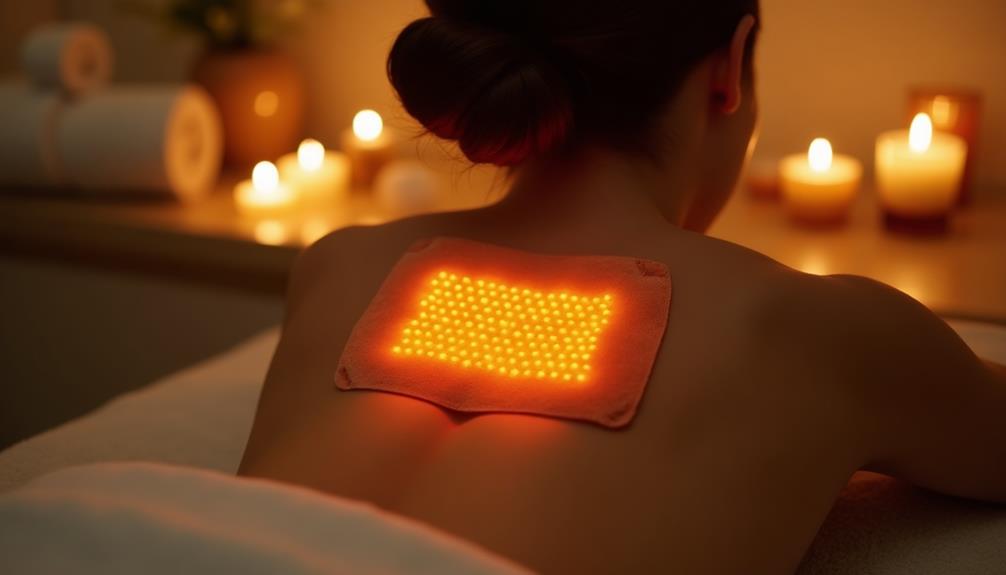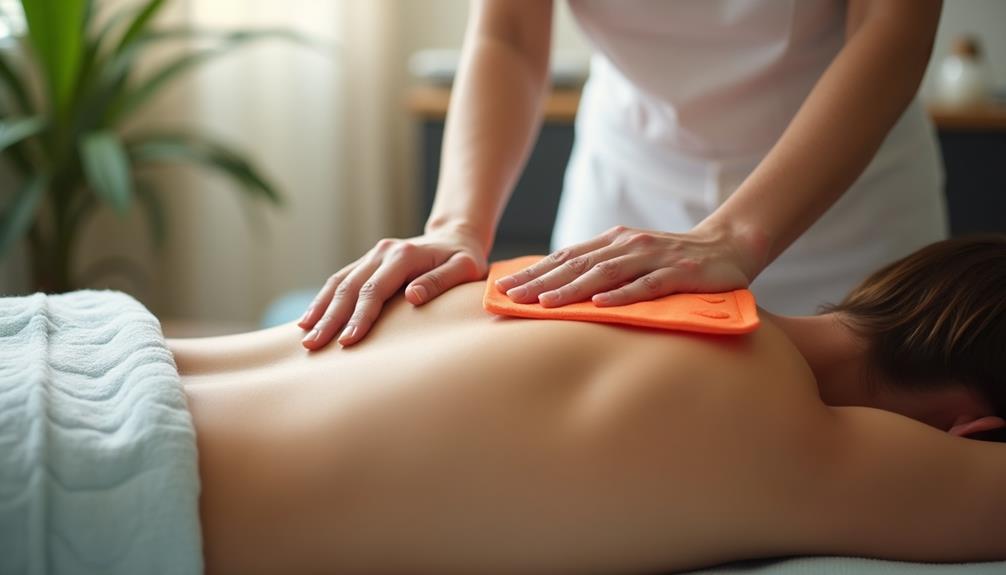Heat therapy is an effective method for muscle recovery that involves applying heat to soothe discomfort and boost blood circulation. This increased blood flow delivers essential oxygen and nutrients to your muscles, aiding tissue repair. It also relaxes tight muscles, reduces stiffness, and enhances flexibility. You can use various techniques like heating pads, warm baths, or hot towels to target sore areas. It's best to apply heat within 24 to 48 hours after exertion, keeping sessions to about 20 minutes. If you're curious about combining heat therapy with other techniques for improved recovery, there's more to explore.
Core Insights
- Heat therapy involves applying heat to muscles to alleviate pain and promote recovery by increasing blood flow and delivering nutrients.
- It relaxes tight muscles, reduces stiffness, and enhances flexibility, making movement more comfortable.
- Techniques include heating pads, warm baths, and hot towels, each providing targeted relief and relaxation.
- Ideal for use within 24 to 48 hours post-exercise, heat therapy can also warm up muscles before workouts.
- Always consult a healthcare professional before starting, and limit sessions to 20 minutes to prevent burns or overheating.
What Is Heat Therapy?

Heat therapy is a treatment method that involves applying heat to the body to alleviate pain and promote recovery. You might use it after a workout or during muscle soreness. The heat helps increase blood flow, which can deliver more oxygen and nutrients to your muscles. While heat therapy is beneficial, it's also important to maintain proper hydration. Electrolyte gummies can help replenish essential minerals lost during intense physical activity. There are different forms of heat therapy, including moist heat, like warm towels or hot baths, and dry heat, such as heating pads. Each type has its benefits, depending on your needs. When applying heat, you'll want to make sure it's warm, not scalding, to avoid burns. It's important to limit sessions to around 20 minutes to prevent overheating and give your body time to recover.
Benefits of Heat Therapy

Many athletes and fitness enthusiasts experience significant relief from muscle soreness and tension through heat therapy. This method offers several benefits that can enhance your recovery process. Infrared heat pads with natural jade and tourmaline stones provide deep tissue penetration for best results. These pads often come with adjustable temperature settings, allowing for personalized therapy. Here are four key advantages:
- Increased Blood Flow: Heat promotes circulation, delivering more oxygen and nutrients to your muscles.
- Reduced Muscle Stiffness: Applying heat can help relax tight muscles, making movement easier and more comfortable.
- Pain Relief: Heat therapy can alleviate discomfort by blocking pain signals and soothing the affected area.
- Enhanced Flexibility: Warmer muscles tend to be more pliable, improving your overall range of motion during workouts or activities.
Incorporating heat therapy into your routine can be a game-changer for muscle recovery and overall wellness.
How Heat Therapy Works

Understanding how heat therapy works can empower you to leverage its benefits for muscle recovery. When you apply heat to your muscles, it increases blood flow. This improved circulation delivers more oxygen and nutrients to the area, which helps repair damaged tissues. While heat therapy is effective, some athletes also incorporate cold therapy compression for a well-rounded recovery approach. Heat also relaxes tight muscles, reducing stiffness and discomfort. Additionally, it can soothe nerve endings, leading to decreased pain perception. As your muscles warm up, their elasticity improves, making it easier for them to stretch and move. This process not only promotes relaxation but also prepares your muscles for further activity. By recognizing these mechanisms, you can effectively utilize heat therapy as a valuable tool in your recovery arsenal.
Techniques for Heat Application

When it comes to effective heat application, several techniques can help you maximize muscle recovery. Here are four methods to contemplate:
- Heating Pads: These are convenient and can be placed directly on sore areas for targeted relief.
- Warm Baths: Soaking in warm water not only relaxes your muscles but also improves circulation.
- Hot Towels: Soaking a towel in hot water, wringing it out, and applying it to your muscles can provide comforting heat.
- Heat Wraps: These are designed to conform to your body, offering consistent warmth to specific muscle groups.
Each of these techniques can be easily integrated into your recovery routine, ensuring you're well-equipped to soothe tired muscles effectively.
Ideal Timing for Use

Timing plays a significant role in maximizing the benefits of heat therapy for muscle recovery. Ideally, you should apply heat within 24 to 48 hours after intense exercise. This timeframe helps relax tight muscles and improve blood flow to the affected area.
If you're dealing with chronic muscle tension, regular heat therapy sessions can be beneficial. You can use it before workouts to warm up your muscles or after to aid in recovery.
It's essential to listen to your body. If you feel discomfort, it might be best to adjust your timing or type of heat application. By being mindful of when you use heat therapy, you'll enhance your recovery and promote overall muscle health effectively.
Precautions and Considerations

Before delving into heat therapy, it's important to take several precautions to safeguard your safety and effectiveness. Here are some key considerations you should keep in mind:
- Consult a Healthcare Professional: If you have any medical conditions, speak with a doctor before starting heat therapy.
- Limit Duration: Don't exceed 20 minutes at a time to prevent skin burns or overheating.
- Check Temperature: Always verify the heat source isn't too hot. Test it on a small skin area first.
- Stay Hydrated: Heat can cause dehydration, so drink plenty of water before and after your session.
Combining Heat With Other Therapies

Combining heat therapy with other recovery techniques can enhance your overall muscle recovery process. You might consider pairing heat with stretching. The warmth helps relax muscles, making them more pliable and receptive to stretching.
Another effective combination is using heat alongside foam rolling. The heat increases blood flow, allowing your tissues to loosen up, which can make foam rolling more effective.
Additionally, combining heat therapy with massage can provide profound relief. The heat prepares your muscles for deeper manipulation, promoting better circulation and reducing soreness.
Always listen to your body when mixing these therapies. Start slowly and observe how your muscles respond. By integrating heat with other methods, you can create a well-rounded recovery routine tailored to your needs.
Frequently Asked Questions
Can Heat Therapy Be Used for Chronic Pain Management?
You might've noticed that heat can soothe aches. Yes, heat therapy can effectively manage chronic pain, increasing blood flow and relaxing tight muscles. It's a simple yet powerful tool to help you feel better.
Is Heat Therapy Safe for All Age Groups?
Yes, heat therapy's generally safe for all age groups, but you should consult a healthcare professional first. They can help determine the right approach and guarantee it's appropriate for your specific health needs.
How Does Heat Therapy Compare to Cold Therapy?
Heat therapy relaxes muscles and increases blood flow, while cold therapy numbs pain and reduces inflammation. Depending on your needs, you'll find one method provides more immediate relief or long-term benefits than the other.
Are There Specific Injuries That Heat Therapy Should Avoid?
If you imagine a steaming cup of coffee, remember that heat therapy isn't for everyone. Avoid it for fresh injuries, inflammation, or conditions like swelling, as it can worsen pain and delay recovery instead of helping.
Can Heat Therapy Be Applied During Exercise?
You can use heat therapy during exercise, but it's essential to listen to your body. If you feel discomfort or increased pain, it's best to stop and reassess your approach to avoid potential injury.

